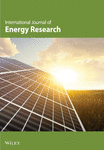Natural vacuum distillation technique—Part II: Experimental investigation
Abstract
This part of the study is concerned with the experimental investigation and uncertainty analysis of natural vacuum distillation process. Natural vacuum distillation (NVD) system is operated in the forms of free and forced mass convection. The experiments are conducted at temperatures of 20 and 40°C of network water as fluid in the system. During the experiments, total pressure losses are measured as 15.33kPa during free mass convection distillation while 14 kPa during forced mass convection distillation. Depending on time and temperature, the ratios of vapour/wastewater (v/ww)free, distilled water/wastewater (dw/ww)forced and total energy/distilled water (te/dw) are experimentally determined. Moreover, the ratios of mass and energy balances are experimentally obtained. Accordingly, it is found that the ratios of (dw)forced/(dw)free vary between 1.4 and 1.6 depending on the wastewater temperatures. In addition, 2.5 kWh kg−1 distilled water is experimentally used in the NVD system with free mass convection while 2.6 kWh kg−1 distilled water in the NVD system with forced mass convection. In case of reduction of heat and pressure losses in the systems, 0.7 kWh is needed for the former while 1.3 kWh of energy is required for the latter. Copyright © 2004 John Wiley & Sons, Ltd.




